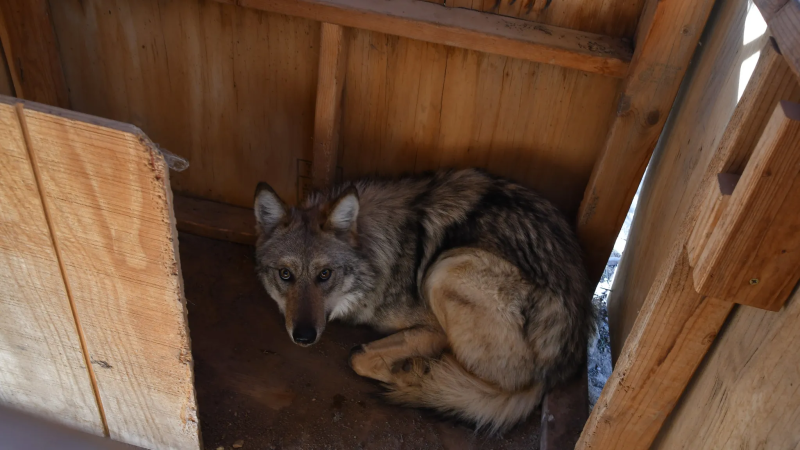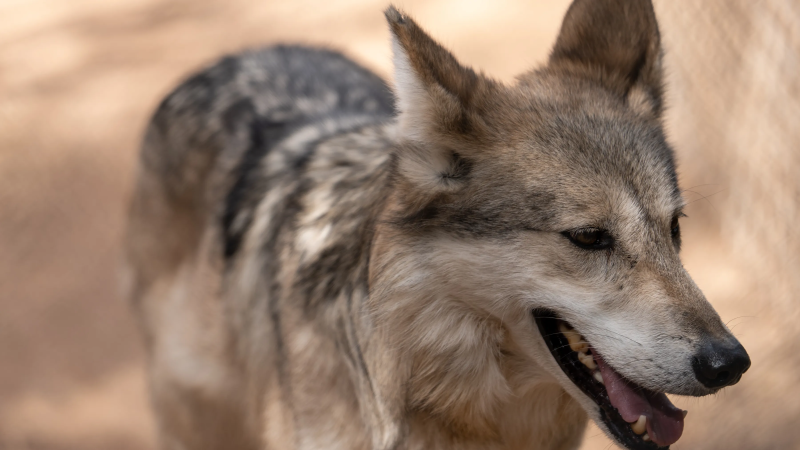Asha traveled over 100 miles across state lines. Now, the endangered Mexican wolf has a mate.
PHOENIX − After her second foray outside of the endangered Mexican gray wolf repopulation area, Asha, Arizona’s most adventurous wolf, has been captured, placed in captivity and paired with a male wolf.
Also known as Mexican wolf F2754, Asha was captured by the New Mexico Game and Fish Department on Dec. 9 near Coyote, New Mexico. She traveled more than 100 miles from the Mexican Wolf Experimental Population area.
Asha first gained public attention in 2022 when she first wandered past Interstate 40, the northern boundary of the habitat area that includes parts of the Apache-Sitgreaves National Forests in Arizona and the Gila National Forest in New Mexico.
The agency had removed her from the wild and paired her with a male wolf in captivity in January of this year, but after they failed to breed, Asha was released in June.
Prosecutors:Two men charged after 'killing spree' of 3,600 birds, including bald eagles
In October, Asha’s telemetric collar alerted the agencies she had again ventured beyond I-40. Officials monitored her movements, and when she showed no signs of returning to the population area, they used a helicopter to find, capture and transport her to the Sevilleta Wolf Management Facility in New Mexico.
Asha has been paired with another male wolf in time for the 2024 breeding season.
“By pairing her with a carefully selected mate in captivity, we are hoping she will breed and have pups this spring,” said Brady McGee, a Mexican Wolf Recovery Coordinator for the U.S. Fish and Wildlife Service. “The best outcome for her is to be released back into the wild, where she and her offspring can contribute to Mexican wolf recovery.”
The Arizona and New Mexico Game and Fish Departments and the U.S. Fish and Wildlife Service recently marked the 25th anniversary of the first Mexican wolves reintroduced to the wild.

The population is steadily growing, and officials are optimistic the subspecies will be removed from the Endangered Species Act in the coming years.
But wolf experts and activists believe more can be done to save the subspecies, including allowing wolves like Asha to roam past I-40 and into the southern Rockies to create a second population.
“Asha is repeatedly telling us what peer-reviewed, independent science also indicates, that lobos need access to this habitat in the southern Rocky Mountains,” said Chris Smith, a Southwest wildlife advocate for WildEarth Guardians.
The path to delisting Mexican wolves
Asha was one of about 242 wild Mexican gray wolves in the U.S., according to the 2022 wolf count. Born in the Rocky Prairie pack in Arizona in 2021, she is part of a decadeslong effort to recover Mexican wolves.
Mexican wolves are a subspecies of the North American gray wolf with a historic range in Mexico, Arizona and New Mexico. The subspecies was added to the Endangered Species List in 1976, with just seven known wolves remaining.
Officials created the experimental population area in 1998, releasing the first packs of captive-born wolves.
Although recovery efforts have had mixed results over the years, the agencies have observed a steady population increase more recently, which they attribute to a fostering program.
In captivity, specific wolves are bred to create genetically diverse pups. The pups are then matched with wild dens to be raised by existing wolf packs in the recovery area. This bolsters the population and introduces valuable genes to the packs.
The Mexican wolf population needs to reach 320 wolves between Arizona and New Mexico for officials to consider delisting the subspecies. Once wolves reach this milestone, the population must maintain a 320-wolf average for eight years, with numbers increasing or remaining stable in the final three years.
Officials hope Asha will produce pups in captivity, strengthening the wolf population on the path to delisting the subspecies.
Advocates believe recovery efforts are ‘not enough’
Activists believe Asha’s repeated attempts to venture past the I-40 boundary show that wolves should be allowed to roam and establish multiple subpopulations across the region.
Greta Anderson, a deputy director for the Western Watersheds Project, believes there should be three subpopulations of wolves: in the Grand Canyon region, the southern Rockies and the current experimental population area.

“We hope that Asha’s movements have spoken to policymakers about how arbitrary the boundary is,” she said, “Just simply managing numbers within the small geography of Arizona and New Mexico is not enough.”
Activists believe the agencies should allow Asha to move into the southern Rockies, using her to start a second subpopulation.
Multiple wild subpopulations can protect the longevity of the subspecies.
If fire, drought or disease wipes out one population, the others can ensure the wild population continues. Activists also believe multiple populations create more opportunities for genetic diversification when wolves from different regions mingle.
According to the USFWS, Asha was recaptured for her own protection. Mexican wolves are sometimes mistaken for coyotes and shot, especially in areas outside the population area where people do not expect to see Mexican wolves.
“Our decision to capture F2754 was made out of concern for her safety and well-being,” McGee said. “Dispersal events like this are often in search of a mate. As there are no other known wolves in the area, she was unlikely to be successful.”
Hayleigh Evans covers environmental issues for The Arizona Republic and azcentral.com. Send tips or questions tohayleigh.evans@arizonarepublic.com.
Environmental coverage on azcentral.com and in The Arizona Republic is supported by a grant from the Nina Mason Pulliam Charitable Trust. Sign up for AZ Climate, our weekly environment newsletter, and follow The Republic environmental reporting team at environment.azcentral.com and @azcenvironment on Facebook, X and Instagram.
You can support environmental journalism in Arizona by subscribing to azcentral today.
Disclaimer: The copyright of this article belongs to the original author. Reposting this article is solely for the purpose of information dissemination and does not constitute any investment advice. If there is any infringement, please contact us immediately. We will make corrections or deletions as necessary. Thank you.






